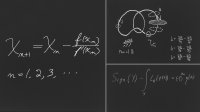Exploring the Beauty in Math
In addition to teaching students about math facts and procedures, teachers can guide them to see it as a creative pursuit.
Your content has been saved!
Go to My Saved Content.Just as art students look at paintings, sculptures, and other objects as works of art, we should expose our math students to the beauty of works of mathematics. Inspired by the 2017 Metropolitan Museum of Art exhibition Picturing Math, I assigned my students a project that involved making a video about an equation they found beautiful.
Everybody knows how useful math is. Its practical applications range from engineering to astronomy, from business to medicine to urban planning. But not everyone is aware of its fascinating nature: In fact, mathematics can have an aesthetic appeal equal to that of anything in the arts.
In the words of the poet Edna St. Vincent Millay, “Euclid alone has looked on Beauty bare,” or, according to Bertrand Russell, “Mathematics, rightly viewed, possesses not only truth, but supreme beauty—a beauty cold and austere, like that of sculpture, without appeal to any part of our weaker nature, without the gorgeous trappings of painting or music, yet sublimely pure, and capable of a stern perfection such as only the greatest art can show.”
So why doesn’t mathematics strike our students this way? Although in our classrooms we often emphasize mathematics as a set of procedures and facts that students learn for their practical and useful purposes (effective thinking and efficient problem-solving), we rarely look at mathematics as an unmatched creative pursuit or pause to savor the magnificence of the discipline’s works and the brilliance of its scholars.
Seeing Math Through an Artistic Lens
When I visited the Picturing Math exhibition, the Concinnitas series, a group of 10 aquatint prints of equations chosen by a prominent group of mathematicians and physicists, struck my imagination, and I couldn’t wait to find a way to share that feeling with my students. My favorite print (for a calculus teacher, it was just like seeing an old friend) was Newton’s Method, about which mathematician Stephen Smale’s comment was “Beauty is simple and it is profound.”
The term concinnitas, as explained in the exhibition guide, comes from Leon Battista Alberti’s 15th-century treatise on architecture and refers to beauty as harmony in numbers and proportion. The idea of the print series began with a chance meeting between a mathematician and a publisher and their conversation about the strong links between art and mathematics. Each of the 10 equations is accompanied by an essay written by the mathematician who chose that equation, and together they’re a testament to the importance of beauty as a motivational force in mathematics.
To share in the experience of the mathematicians’ community is to have a sense of belonging to it—which math students rarely have in their school years: Math work for them is often something to endure rather than to cherish. It’s essential, therefore, that they’re also given the chance to look at works of math as works of art—for example, looking at equations not as hurdles but as objects that inspire a sense of “wonder, joy, and beauty.”
Furthermore, allowing students to choose their favorite equations—even if their repertoire is still limited—adds relevance, ownership, and a sense that their voice is heard and it is important. In short, they feel that they are part of the community of math explorers and learners.
Students find the art in math
In the “My Favorite Equation” project, I divided the students into two groups, and after some research they had to script and design a video in which they would describe and explain their equation and its use, along with the reason for their choice. Here are two examples of works by my Algebra 1 Honors students.
(Keep in mind that this type of video project can be assigned at any level, and the students will respond by simply choosing an equation appropriate for their age group and math or science knowledge.)
The video above describes linear motion, and the video below shows how the nonterminating, repeating decimal .999… equals 1.
These and the other student videos featured rather unassuming yet conceptually powerful mathematical objects with famed history and profound meaning that required the toil of many scholars and have excited generations of people across the world and answered centuries-old questions.
Evaluation was based on self, group, and peer reviews—each of which focused on the NCTM standards of (respectively) problem-solving and representation, collaboration, and communication.
The students’ enjoyment while completing this project and their appreciation for the mathematical work they were describing motivated me to create similar tasks to incorporate choice and relevance and to foster a sense of belonging to the community of mathematics learners.
